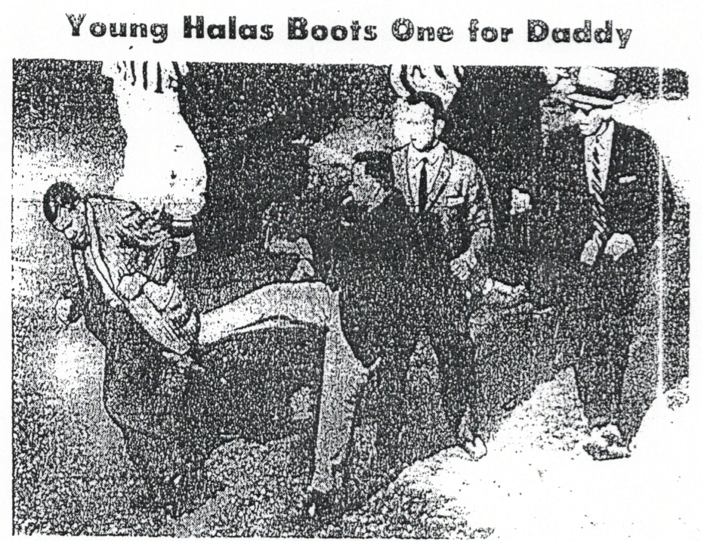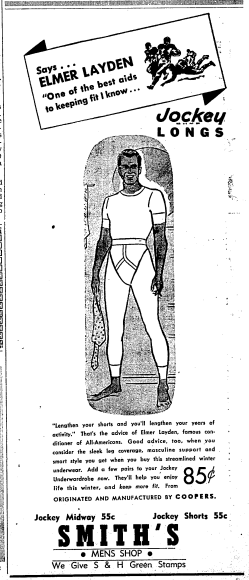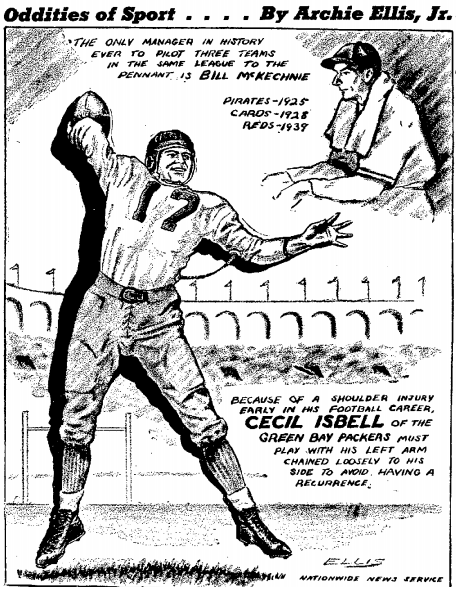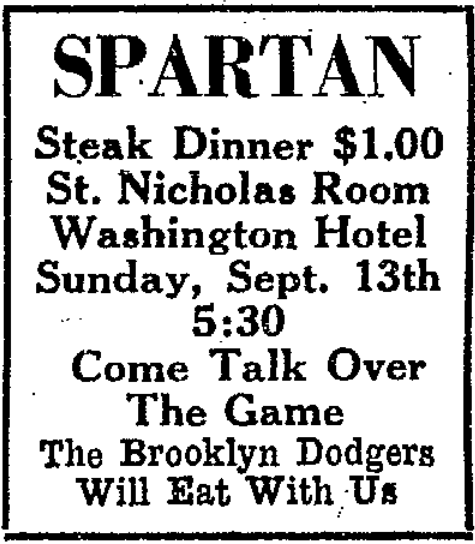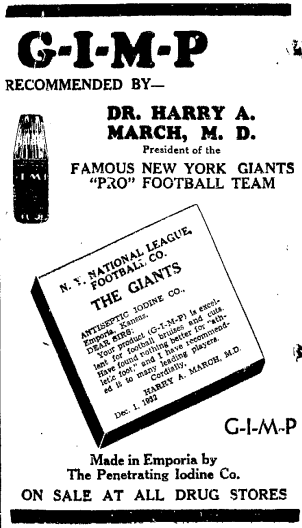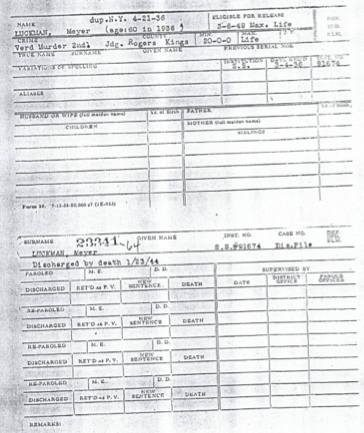At halftime of a 1958 game, a 49ers fan went out on the field at Kezar Stadium to confront Bears coach George Halas, who he thought was trying to intimidate the officials. (Not that Papa Bear would ever do anything like that.) The result was this memorable photo of Halas’ son Mugsy springing to the rescue — while George (the gent to the right in the hat and sunglasses) looked on approvingly. I particularly love the cigarette dangling from Junior’s lips.
Category Archives: From Deep in My File Drawer
NFL briefs . . . and longs
In the days before they made $44.2 million a year, NFL commissioners scratched out an existence any way they could. Elmer Layden, who held the job from 1941 to ’45, pushed Jockey long johns. “Lengthen your shorts,” he said in a newspaper ad, “and you’ll lengthen your years of activity.”
An even more elaborate ad ran in the Oct. 27, 1941, issue of Life magazine.
Cecil Isbell’s unique fashion accessory
The Packers’ Cecil Isbell was one of pro football’s best passers in the prewar years. He set several short-lived NFL records in his career (1938-42) — for passing yards in a game (333) and touchdown passes (24) and passing yards (2,021) in a season, among others — and might be in the Hall of Fame if he hadn’t retired at 27 to go into coaching.
And he did all this despite wearing a chain — secured by a harness — that ran from his waist to his upper left (non-throwing) arm, limiting the range of motion and keeping the shoulder from popping out of the socket. He’d suffered a bad separation in college and was worried it might happen again.
A cartoonist’s rendering of Isbell’s unusual piece of equipment:
R. C. Owens’ one-of-a-kind field-goal block
A couple of years ago, when R. C. Owens died, newspapers mentioned the unusual way he’d once blocked a field goal try for the Colts. From his New York Times obituary:
In 1962, the 6-foot-3 Owens wowed fans by standing under the goal post at the goal line (goal posts have since been moved to the back of the end zone) and leaping to block a long, line-drive field-goal attempt by the Washington Redskins. The tactic was legislated out of existence.
Unfortunately, none of Owens’ obits featured a photo of his amazing play, perhaps because papers couldn’t find one. I ran into the same problem 25 years ago when I was digging up art for my first book, The Pro Football Chronicle. Nobody had kept the negative — or something.
Too bad. As you can see, R. C. really got up there. He was already on his way down (along with the ball) when this was snapped. Don’t ask me where it came from.
(For more, see: “R. C. Owens’ one-of-a-kind block, revisited.”)
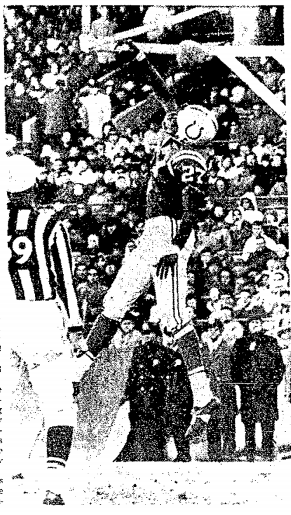
Guess who’s coming to dinner?
The close connection between fans and pro football players in the early years, especially in small towns like Portsmouth, Ohio, is hard to imagine today. After the Spartans’ 14-0 win over the Brooklyn Dodgers in the 1931 season opener, locals flocked to a dinner attended by both teams. The invitation that ran that day in the Portsmouth Times:
The “Savagery on Sunday” trial
In October 1955 Life magazine tackled the issue of NFL violence head-on with an exposé titled:
Not surprisingly, two of the players the magazine identified as “bad boys,” middle guard Bucko Kilroy and linebacker Wayne Robinson of the Eagles, brought $250,000 libel suits against the publisher, Time, Inc. This led to one of the more entertaining — and educational — trials in league history.
The case wasn’t tried until 1958, by which time Kilroy and Robinson were retired. Here’s an excerpt from Kilroy’s testimony that deals with an episode during the ’48 preseason, when he kicked Bears guard Ray Bray in the groin. Keep in mind this is the future general manager of the Patriots talking:
https://profootballdaly.com/wp-content/uploads/2014/07/Kilroy-Testimony-Excerpt.pdf
In the end, Life‘s “evidence” was too shaky to hold up. Kilroy and Robinson didn’t walk away with $250,000 for having their characters impugned, but they were awarded $11,600 each, which is more than either ever made in a season. More important, as far as the NFL is concerned: no publication since has gone after it so aggressively on the problem of dirty play. It’s just a hard accusation to prove, given the nature of the sport.
Down the road, I’ll post more testimony from the trial, which lasted eight days and saw Commissioner Bert Bell and fellow Hall of Famers Otto Graham, Doak Walker and Em Tunnell called to the stand. You haven’t lived until you’ve read the following words, straight from the commish’s lips:
I don’t read the rules too thoroughly. . . . I couldn’t study those rules in a hundred years. They are technical in every way else.
Sports medicine in the ’30s
The Giants’ first general manager, Dr. Harry A. March, was an actual medical doctor (and formerly the medical examiner in Canton, Ohio). Naturally, he had more than a passing concern for the players’ health. He even endorsed a miracle product he claimed was “excellent for football bruises and cuts” and — as if that weren’t enough — the best remedy for athlete’s foot. The newspaper ad:
Meyer Luckman’s file card at Sing Sing prison
Sid Luckman, the Bears’ Hall of Fame quarterback, was a senior at Brooklyn’s Erasmus Hall High when his father Meyer was arrested for murder in 1934. His dad wound up spending the last eight years of his life in Sing Sing prison, and never saw Sid play at Columbia or in the NFL. It was one of the great unwritten sports stories of the ’40s.
Somebody at the New York Department of Corrections was good enough to send me a copy of Meyer’s Sing Sing file card. As you can see, he was serving a 20-years-to-life sentence for Murder 2, and was eligible for parole March 6, 1949 — Sid’s next-to-last season. His heart gave out, though, in January 1944.
One last thing: His “S.S.#” — 91674 — obviously isn’t his Social Security number; there aren’t enough digits. It must be his Sing Sing number. Lucky Luciano, who was at the prison at the same time, was number 92163.

